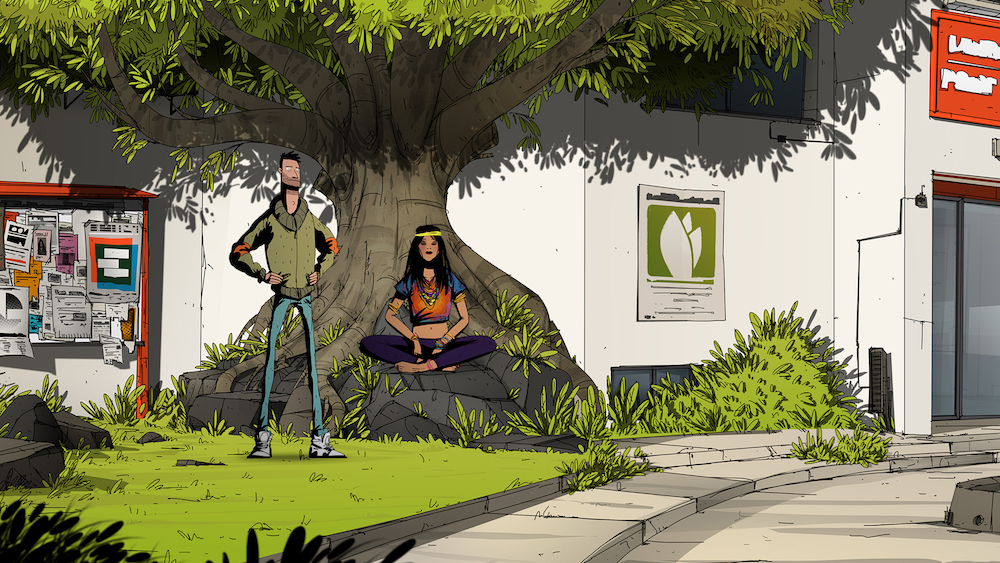
It’s with an unshakeable sense of surprise I write you this review of Unforeseen Incidents – which is somewhat fitting, I guess, given the title. A point-and-click adventure, the first from a tiny, unknown indie developer, and it’s…actually excellent? What? That’s not how the script goes! How…unforeseen. As handyman Harper Pendrell, the player has to investigate a deadly virus and the shady health corporation who are meant to be containing it, via the usual mechanisms of item collecting, negotiating and puzzle-solving. There is little innovative about it, but it does all the important things well. I had a great time.
The conspiratorial plot serves a sprawling, teasing adventure where answers frequently lead to more questions. With each chapter set in a different locale, we follow Harper from a small village to a big city, interspersed with visits to a forest and a snowy wasteland. There’s a real breadth of place here, well-realised by beautiful background artwork which I have a lot of compliments in the bank for; notably, the urban environments manage to simultaneously depict aesthetically pleasing construction and dereliction, which along with little background details successfully imply a world that continues outside the scenes’ borders. Here, too, the developers’ European origins undercut the (I think supposedly) American setting, with stone-cobbled streets, clustered terrace housing and prominent use of vertical space. Great attention to lighting throughout adds a great sense of weight to the world and helps balance the mood of the game against Harper’s perennial optimism.

The puzzles are not particularly ground-breaking or outrageous, but they feel fresh, inventive and quirky, and there’s a good sense of pace and variety to them that keeps the game moreish and considered without ever making it feel rushed or chaotic. On the hunt to unravel the mystery, Harper has to undertake a series of tasks that go from the hilariously inane to the obtuse to the technical – there’s a lot of the “fetch a food/drink for this person so you can borrow their item,” but then at other times Harper has to put together a car engine from scrapyard parts, or create some homebrew film development solution following an instruction manual. There’s the familiar reliance on outdated technologies to provide some tactility, despite taking place in the present, almost everyone seems to rely on systems that haven’t been updated for years. It would be corny if it didn’t fit so well with the story and the off-the-map places and people that it depicts.
For the most part, the difficulty feels about right: hard enough to require some thinking and make reaching solutions feel adequately rewarding, while rarely feeling unfair or that it was intentionally trying to trick the player. The developers have made the game a great deal more accessible by letting you have every interactive object on the screen highlighted by pressing the spacebar. This may not sound like a big deal, but in the moments you get stuck it takes a great deal of the frustration away by allowing you to eliminate the chance that there’s an object you just haven’t found yet. This isn’t to say imply it’s been made easy – to be honest, I still got stuck a few times – but I never felt like I was being particularly hard done by questionable event sequencing or overly hidden information.

It helps that Harper is a genuinely likeable protagonist: funny, self-depreciating, handy but no superhero, strangely chipper in the face of adversity, modestly intelligent and self-aware. Endearingly, he relies on a multi-tool for pretty much everything – I’m torn between criticising how only half of its components are ever really used here, and reconciling that the same is true of the one I own. The writing is smart throughout, with varied characters, engaging dialogue, the occasional gag or witty throwaway line. It keeps up an investigative, optimistic and light tone without jarring with the heavier, mass-murderous subject matter of the plot. It’s all well voice-acted too, which might seem like the bare minimum but believe me, you play enough point-and-clicks where this aspect has been skimped on or miscast.
Which isn’t to call it flawless. It suffers from some glitchy animation, and as such the few “action” sequences are pretty rough. The good voice work is occasionally let down by some poor volume mixing or muffled recording. And while the game’s art is mostly excellent and the designers have done a great job within limitations, I’d caveat that some of the facial expressions sometimes look needlessly dopey (particularly the female characters, for some reason). Also, I’ll admit that the ending was a minor let-down, although I do think that conclusions to conspiratorial plots like this rarely manage to live up to the feeling of suspense and intrigue that they build throughout. It’s kinda the nature of the genre. Still, these are relatively slight smudges.

Unforeseen Incidents is a smart, funny, engaging, thoughtfully-designed adventure game, probably one of the best traditional point-and-click mysteries that I’ve played in years. In story, dialogue, artwork, puzzle building, pacing and accessibility, it cuts well above its newbie-studio weight. It’s more than the sum of its parts, and its parts are all outstanding. I wholeheartedly recommend it both to fans of the genre and curious newcomers alike.











